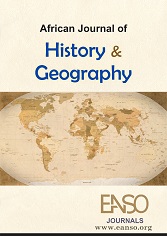Risk Vulnerability Mapping and Resilience Strategies of Populations Facing Flooding in Urban Environments: Case of Maroua, Far North, Cameroon
Abstract
Flood disasters pose a significant and enduring global challenge, disproportionately impacting urban populations in vulnerable regions like Africa, where accelerated urbanization and climate change exacerbate risks. This study examines community vulnerability and resilience strategies in response to flooding in Maroua, located in Cameroon’s Far North region. By integrating geospatial data for flood risk and vulnerability modelling, field surveys encompassing 400 households, and satellite imagery analysis, we assess the spatial distribution of flood risk, vulnerability, and the socio-economic and infrastructural impacts on at-risk populations. Our analysis reveals a substantial increase in flood risk over time, driven by the expansion of built-up areas from 6.18 km² in 1986 to 21.22 km² in 2024. Approximately 82% of surveyed households reported flood exposure, with impacts ranging from impaired mobility to fatalities. In response, communities have adopted adaptive measures, including elevating building foundations and employing resilient construction materials. These findings offer critical insights for policymakers seeking to improve the resilience and living conditions of Maroua’s flood-prone populations
Downloads
References
Adger, W. N. (2006). Vulnerability. Global Environmental Change, 16(3), 268–281.
Amanejieu, A. (2019a). Hydrological risks in northern Cameroon: A case study of Meiganga. Journal of Environmental Studies, 12(3), 45–60.
Amanejieu, A. (2019b). Urban flooding in Douala: Historical perspectives. African Urban Studies, 15(2), 89–102.
Bouba, A., et al. (2017). Flood risk assessment in the Far North Region of Cameroon. Journal of Environmental Management, 45(2), 123–135.
Canton, H. (2021). Office for the Coordination of Humanitarian Affairs—OCHA. In The Europa Directory of International Organizations 2021 (pp. 153–155). Routledge.
Chen, Y., Liu, R., Barrett, D., & Zhang, B. (2019). A spatial assessment framework for evaluating flood risk and resilient city performance: A case study. Journal of Cleaner Production, 227, 139–150.
Dandapat, K., & Panda, G. K. (2017). Flood vulnerability analysis and risk assessment using analytical hierarchy process. Modeling Earth Systems and Environment, 3, 1627–1646.
Dusseux, P. (2014). Land use classification using remote sensing: Methods and validation. Remote Sensing Reviews, 33(1), 89–102.
Hallegatte, S., Vogt-Schilb, A., Bangalore, M., & Rozenberg, J. (2016). Unbreakable: Building the resilience of the poor in the face of natural disasters. World Bank Publications.
Hamdja Ngoniri, A., et al. (2024a). Flood dynamics and community responses in Maga, Cameroon. Journal of Sahelian Studies, 15(1), 78–95.
Hamdja Ngoniri, A., et al. (2024b). Urban flooding and vulnerability in Cameroon: A review. International Journal of Disaster Risk Reduction, 52, 101–115.
Hoarau, K., et al. (2019). Assessing flood vulnerability in urban areas. Natural Hazards, 98(1), 235–250.
Intergovernmental Panel on Climate Change (IPCC). (2014). Climate change 2014: Impacts, adaptation, and vulnerability. Cambridge University Press.
Kreibich, H., Thieken, A. H., Petrow, T., Müller, M., & Merz, B. (2005). Flood loss reduction by flood-resistant building design. Natural Hazards and Earth System Sciences, 5(4), 575–582.
Leumbé Leumbé, S., et al. (2015). Soil characteristics and flood vulnerability in Sahelian Cameroon. Environmental Science Journal, 10(4), 201–218.
Marto, R., Papageorgiou, C., & Klyuev, V. (2018). Building resilience to natural disasters: An application to small developing states. Journal of Development Economics, 135, 574–586.
Mbevo Fendoung, P. (2019). Climate change and flood risks in African cities. Journal of Urban Studies, 33(4), 567–580.
Mediebou Chindji, R. (2021). Urbanization and land use in Cameroon. Cameroon Journal of Geography, 18(1), 22–35.
MINAT. (2022). Annual report on natural disasters in Cameroon. Ministry of Territorial Administration.
National Institute of Statistics (Cameroon). (2020). Enquête démographique et de santé Cameroun. ORC Macro.
OCHA. (2020). Humanitarian impact of flooding in Cameroon’s Far North Region. United Nations Office for the Coordination of Humanitarian Affairs.
Saaty, Thomas.. L. (1980). The analytic hierarchy process: Planning, priority setting, resource allocation. McGraw-Hill.
Seto, K. C., Fragkias, M., Güneralp, B., & Reilly, M. K. (2011). A meta-analysis of global urban land expansion. PLoS ONE, 6(8), e23777.
Shuster, William D., James Bonta, Hale Thurston, Elizabeth Warnemuende, & Douglas R. Smith. (2005). Impacts of impervious surface on watershed hydrology: A review. Urban Water Journal 2(4), 263-275.
Smith, A., Sampson, C., Neal, J., Bates, P., Trigg, M., Freer, J., & Fewtrell, T. (2018). Estimating large-scale flood risk for the continental United States using a multi-model approach. Water Resources Research, 54(9), 7249–7270.
Wanie, C. M., & Ndi, R. A. (2018). Governance issues constraining the deployment of flood resilience strategies in Maroua, Far North Region of Cameroon. Disaster Prevention and Management: An International Journal, 27(2), 175–192.
Yuen, B., & Kumssa, A. (2011). Africa and Asia: Two of the world’s fastest growing regions. In Climate change and sustainable urban development in Africa and Asia (pp. 3–18).
Copyright (c) 2025 Lila Reni Bibriven, PhD, Fotsing Marcel Junior, Aoudou Doua Sylvain, PhD

This work is licensed under a Creative Commons Attribution 4.0 International License.




























